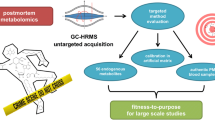Abstract
Metabolomics technology, employed in the analysis of low-molecular endogenous metabolites (e.g., by NMR, LC/MS, GC/MS) and with statistical algorithms, has been applied to the development of new drugs, the diagnosis of diseases, and a variety of other fields. In the present research, certain endogenous metabolite candidates with which, by application of metabolomics to forensic science, post-mortem changes can be inferred were postulated. We combined UPLC/Q-TOF MS-based metabolomics with a statistical analysis to search for metabolite changes related to the post-mortem interval. Metabolites extracted from the livers of rats 0, 24, and 48 h post-sacrifice were analyzed by UPLC/Q-TOF MS. After acquiring the exported UPLC/Q-TOF MS data, PCA, PLS-DA, OPLS-DA and R were applied to identify the significantly up/down regulated metabolites. Comparing the postulated metabolites list with the Human Metabolome Database (HMDB: http://www.hmdb.ca), we could classify samples for post–mortem-interval prediction.



Similar content being viewed by others
References
Chen C, Gonzalez FJ, Idle JR (2007) LC-MS-based metabolomics in drug metabolism. Drug Metab Rev 39:581–597
Choi MY, Park JH (2009) Original articles: determination of aspirin tablet manufacturers by an nmr-based metabolomic approach. J Kor Pharm Sci 39:43–49
Coe JI (1993) Postmortem chemistry update—emphasis on forensic application. Am J Forensic Med Pathol 14:91–117
Di Maio V, Di Maio D (2001) Time of death. Forensic Pathology, 2nd edn. CRC Press, New York, p 24
Henssge C, Madea B (2007) Estimation of the time since death. Forensic Sci Int 165:182–184
Kaliszan M, Hauser R, Kernbach-Wighton G (2009) Estimation of the time of death based on the assessment of post mortem processes with emphasis on body cooling. Legal Med 11:111–117
Masson P, Alves AC, Ebbels TMD, Nicholson JK, Want EJ (2010) Optimization and evaluation of metabolite extraction protocols for untargeted metabolic profiling of liver samples by UPLC-MS. Anal Chem 82:7779–7786
Werner E, Croixmarie V, Umbdenstock T, Ezan E, Chaminade P, Tabet JC, Junot C (2008) Mass spectrometry-based metabolomics: accelerating the characterization of discriminating signals by combining statistical correlations and ultrahigh resolution. Anal Chem 80:4918–4932
Wiklund S, Johansson E, Sjostrom L, Mellerowicz EJ, Edlund U, Shockcor JP, Gottfries J, Moritz T, Trygg J (2008) Visualization of GC/TOF-MS-based metabolomics data for identification of biochemically interesting compounds using OPLS class models. Anal Chem 80:115–122
Acknowledgment
This study was supported by the R&E program (2011).
Author information
Authors and Affiliations
Corresponding author
Rights and permissions
About this article
Cite this article
Kang, YR., Park, Y.S., Park, Y.C. et al. UPLC/Q-TOF MS based metabolomics approach to post-mortem-interval discrimination: mass spectrometry based metabolomics approach. Journal of Pharmaceutical Investigation 42, 41–46 (2012). https://doi.org/10.1007/s40005-012-0006-7
Received:
Accepted:
Published:
Issue Date:
DOI: https://doi.org/10.1007/s40005-012-0006-7




